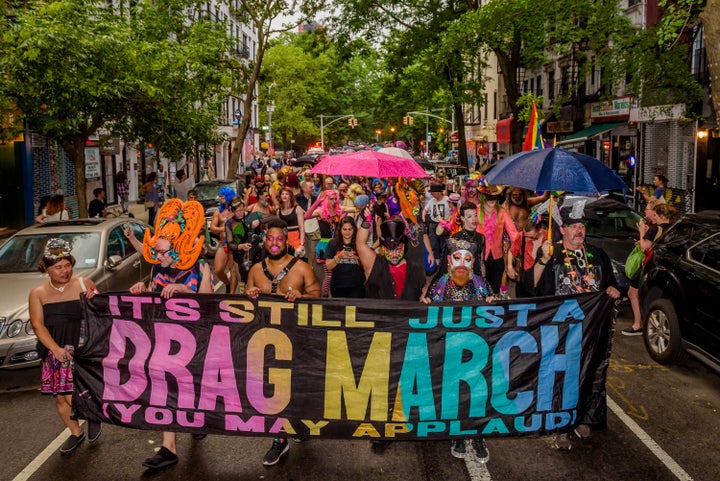
Every June, thousands of queens from around the country gather in Tompkins Square Park in New York City’s East Village for the annual New York City Drag March. The drag ranges from elaborate to haphazard — attendees are as likely to see a mug painted fierce enough to win a “RuPaul’s Drag Race” challenge as they are to see a bearded man with a lopsided wig tottering in too-small high heels or a leather daddy with smeared lipstick.
The march route takes the queens down Ninth Street, through Washington Square Park before finally ending in front of The Stonewall Inn — appropriate, since the march was born during the Stonewall 25th anniversary celebrations in 1994.
Brian Griffin, aka Harmonie Moore Must Die, was a member of the AIDS advocacy group ACT UP and Women’s Health Action and Mobilization (WHAM) in the mid-1990s, an activist who saw the power of drag to confront intolerance and practice civil disobedience in a way that also celebrated queerness. But at planning meetings for the Stonewall 25th anniversary celebrations, Griffin told HuffPost, the committee made it clear that it was only interested in presenting a somewhat sanitized version of LGBTQ activism.
“The committee for Stonewall 25 had actually asked — and it still seems quite unbelievable — that they didn’t want anyone to show up in leather or drag. It still, 25 years later, blows my mind,” Griffin said. “They wanted to normalize the image of gay America for a mass audience. They wanted to present a palatable image of gay men and women, men and women who were normal.”
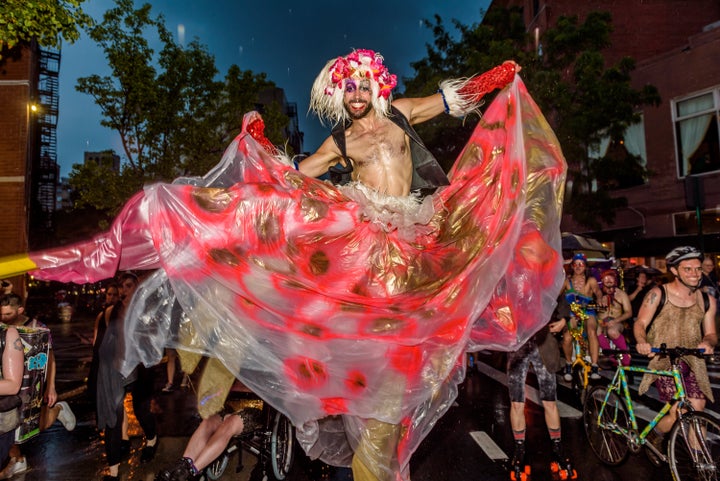
Gilbert Baker, the designer of the rainbow flag, was in New York City sewing a mile-long flag for the Stonewall anniversary celebrations, which included the Gay Games, a worldwide LGBTQ sporting event. It was Baker who had the idea to plan a drag march, and Griffin’s experience working with ACT UP and WHAM was instrumental in bringing the idea to fruition. “I saw the pathway in 10 seconds,” he said.
Griffin was also a member of Church Ladies for Choice, a group that dressed in drag as Bible-fearing church ladies and defended abortion clinics that were under siege from anti-abortion group Operation Rescue. Inspired by the San Francisco group Sisters of Perpetual Indulgence, who didn’t yet have a presence in New York, the Church Ladies for Choice began collecting church pamphlets and replicating them to advertise the march, changing the slogan “Jesus Loves You” to “Jesus Loves Drag.” They began distributing the pamphlets to gay bars, and the response was immediate.
“When this committee asked that no one show up in drag or leather, it angered a lot of people, and I saw that anger as a kind of currency that I could spend,” explained Griffin. “It was money in the bank ― all I had to do was put the word out that there was a drag march happening, and it was going to happen all by itself because people were furious. At the actual Drag March, when I would talk to people, there was a lot of righteous anger. How dare they? Stonewall queens were drag queens — I know the history is more varied than that, but how dare they try to exclude us from the celebration 25 years later?”
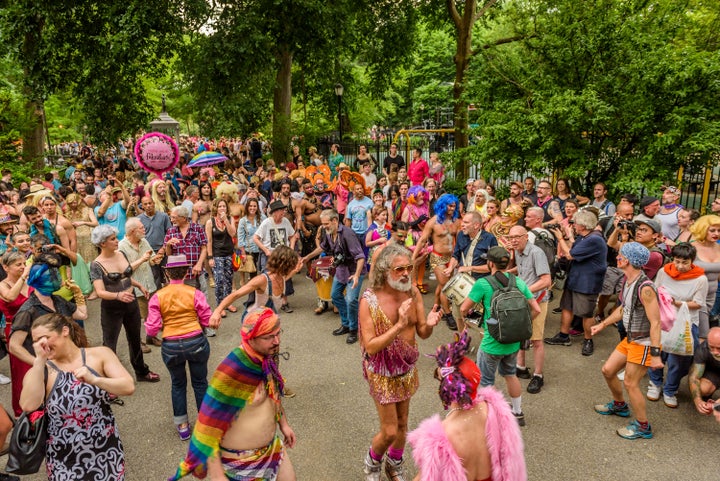
Griffin estimates that the first Drag March took up roughly 10 city blocks, with approximately 1,000 marchers per block — 10,000 queens channeling their anger into something celebratory by refusing to let queerness be normalized. Marchers came in from all over the country, bringing looks, banners and chants — many of which are still used to this day. The chants were largely absurdist, with a favorite being, “two, four, six, eight — it’s no so much the heat as the humidity.” At a certain point on the route, the entire march sang the theme song from “The Mary Tyler Moore Show,” which marchers still do today. The organizers also painted a banner that read, “It’s just a drag march, you may applaud.”
The Drag March was born not only to honor the Stonewall riots, but also the Tompkins Square riot of 1874 — where thousands of unemployed New Yorkers demonstrated to demand that the government establish public works programs following the Panic of 1873 and the ensuing depression — as well as the Tompkins Square Park riot of 1988, in which the city attempted to impose a curfew to drive out the squatters and punks who had been living in the park. After moving along Ninth Street, the march culminated in front of The Stonewall Inn, and the question of what to do when they arrived was quickly solved. “You get that many queens together you wonder, what should we do? Well, let’s sing ‘Somewhere Over the Rainbow,’” said Griffin.
For the first march, Griffin and the other organizers — Steve Quester (aka Felicity Bundtcake), Donald Grove (aka Bessie Mae Mucho), Alexis Danzig and Honora Gibbons — chose not to contact the police to apply for a permit, though they formed a marshaling crew to protect the marchers from traffic and had legal support on standby if anyone was arrested. “But the cops know better, they know the trouble that would cause,” said Griffin.
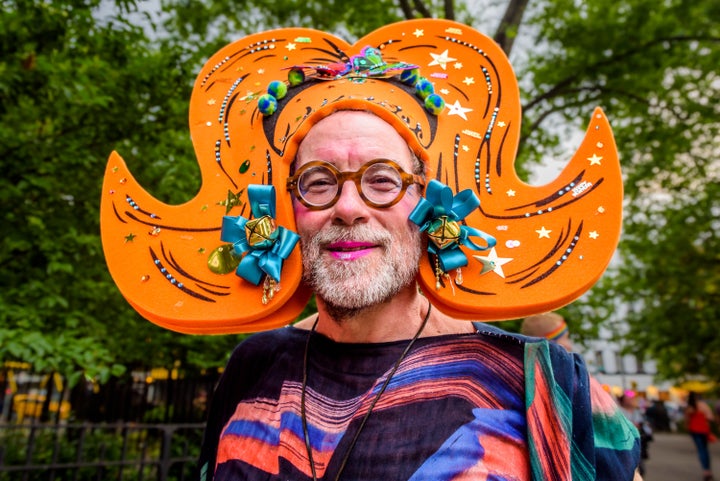
Griffin was instrumental in organizing the march from 1994 to 1997 before leaving to work at a repertory theater in Colorado. In his absence, the Radical Faeries — a group that fuses queerness, sexuality and spirituality — helped keep the march alive, although for years it was much smaller than it had been initially. Hucklefaery, a Radical Faerie and Sister of Perpetual Indulgence, became involved in 1998.
The influence of the Radical Faeries infused the march with more ritualized aspects, like the creation of sacred circles and the calling of the corners (North, East, South and West) and their respective elements (earth, air, fire and water). Nowadays, when the circle is being formed, Griffin and the other Church Ladies enter into it and sing their hymn, “God is a Lesbian,” as a blessing to the crowd.
“When we are standing in a circle holding hands, not only do we offer a unified presence to those observing, we offer ourselves an opportunity to witness everyone in our circle,” Hucklefaery told HuffPost. “We are touching, we are connected — and when we speak our words together, we are unifying our intentions: to honor our ancestors; to celebrate those of us present at the March; and by being present, we are catalysts for a future yet unrealized.”
Hucklefaery continued: “I didn’t want to get to ‘woo woo’ with the spirituality of the circle, for fear of alienating folks, but I also feel no matter your scientific base or spiritual base — I think everyone can agree that words and intentions matter.”
“To me, forming this circle becomes representative of the diversity of our community and the unity of our community,” Hucklefaery added. “We’re a diverse community that’s represented by a rainbow flag because we’re these smaller communities that make up a larger whole.”
While the Radical Faeries of the ’90s were predominately white gay men, they were well aware of the fact that people of color, trans people and gender nonconforming people were being institutionally marginalized and disproportionately targeted by violence — whether it be physical, judicial, social or legislative.
“Within the actions of the Radical Faeries, we approached this in a very playful manner,” Hucklefaery said. “It wasn’t necessarily about venting our anger, even though we all had a great amount of anger. It was about creating a space that was inclusive, that celebrated solidarity and that created a unified presence that would hopefully include all of our people.”
As the gay rights movement has become more mainstream and more concerned with heteronormativity, so has Pride become more normalized and corporatized. The Drag March stands as one of the few holdouts of an angrier, more punk tradition of Pride — though one that still celebrates the spectrum of queer identity.
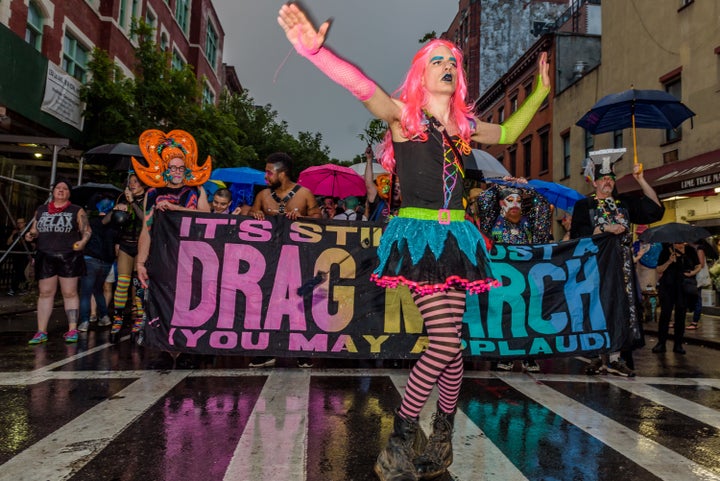
But even drag itself, a punk art form deeply rooted in queer nightlife, has itself become mainstream thanks to the popularity of “RuPaul’s Drag Race.” Drag is no longer something fully owned by queer people — it’s broadcast into living rooms every Thursday night, consumed and replicated by teenage girls on Instagram. So in 2018, are a few thousand queens marching through Manhattan still radical?
“To me, the Drag March’s dirty secret is, a lot of it is really dull and nobody is watching us,” Griffin said with a laugh. “It’s a radical act in that it is an investment in self as opposed to an attempt to fulfill an external idea of what we should be. The Drag March is about self-discovery, externalizing and making manifest a part of yourself, bringing out that magic so that it can become a part of you. That’s an incredibly radical act.”
And the fact that to this day the Drag March is still an illegal, unsanctioned gathering flies in the face of mainstream Pride, where corporations and banks attempt to entice consumers with branded floats and rainbow-emblazoned products.
“I’m tired of seeing corporate sponsors target our community as a commercially viable demographic to make money off of as opposed to actually supporting our rights, whether they be social or legislative,” said Hucklefaery. “The Drag March specifically is noncommercial, it’s essentially a leaderless event where everybody is welcome to step forward and be seen and heard.”
“Any time you have people who are aggressively marginalized and targeted by society become visible, that becomes a radical act, especially if you’re doing so in a way that focuses on the solidarity [and] humanity of the movement,” Hucklefaery added.
As an activist who worked with ACT UP, Hucklefaery understands the power of anger, but believes that creating a dialogue can be even more powerful.
“I don’t think you’re going to change anyone’s mind by yelling at them. However, if you present something in a way that is accessible to them to understand, it may in fact plant a seed of change.”
The 2018 Drag March took place on June 22.
#TheFutureIsQueer is HuffPost’s monthlong celebration of queerness, not just as an identity but as action in the world. Find all of our Pride Month coverage here.